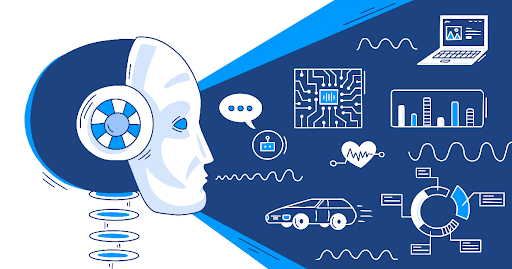How AI thinks and acts
Can AI Really Think?

AI, or Artificial Intelligence, doesn't "think" exactly like people do. When we think, we use our brains, feelings, and experiences. But AI doesn’t have feelings, and it doesn’t understand the world like we do. Instead, it follows rules and looks for patterns in information to make decisions. It’s more like a super-smart calculator than a real brain.
Imagine you have a giant maze, and you need to find the fastest way out. AI would look at all possible paths and pick the best one without getting tired or confused. That’s how it "thinks" — by solving problems quickly and accurately.
How Does AI Make Decisions?
AI makes decisions by following these simple steps:
Collecting Information – AI looks at data, like pictures, sounds, or numbers. This is like gathering clues to solve a mystery.
Recognizing Patterns – AI studies this information and tries to find patterns. For example, if it sees pictures of dogs, it starts to learn what dogs look like by noticing things like fur, ears, and tails.
Making Choices – After learning patterns, AI can start making choices. For example, it might decide, "This picture looks like a dog" or "This video might be interesting to you." It picks the answer that seems the best based on what it has learned.
Learning and Improving – AI doesn’t just stop after making one choice. It keeps learning from new information, getting better at making choices over time.
Types of Thinking in AI
AI uses different ways of "thinking" to solve problems. Here are some types:
If-Then Rules – Some AI works by following very simple "if-then" rules. For example, "If the road is clear, then move forward." This is like following instructions or rules step by step.
Learning by Example – Some AI learns by seeing lots of examples, like a kid learning to recognize animals by looking at different pictures of them. This type of AI might look at thousands of pictures of cats to learn what a cat looks like.
Trial and Error – Some AI tries different things until it finds the best solution. This is similar to playing a game and trying different moves to win. After trying many options, AI remembers the ones that work best.
How AI Acts Like It’s Thinking
AI can sometimes seem like it’s "thinking," especially when it answers questions or suggests something you might like. But AI is just really good at guessing the answer based on patterns. Here’s how it works in some cool examples:
Chatbots – When you type a question to a chatbot, AI looks at your words, finds similar words in its data, and tries to answer based on what it has learned. It doesn’t really know what you’re asking; it just matches your words to answers it already has.
Self-Driving Cars – A self-driving car doesn’t actually know what a "car" or a "road" is. It just follows patterns it has learned from millions of images and sensor data to know when to stop, turn, or slow down.
Game AI – When you play a video game with AI opponents, they seem like they know how to "think" and plan moves. In reality, they are just using patterns and rules to decide what move to make next.
Learning from Mistakes
One of the coolest things about AI is that it can learn from mistakes. If an AI program makes a wrong guess, it can use that mistake to get better the next time. Imagine if every time you missed a question on a test, you got a little better at answering questions. AI does this all the time!
This process is called training. AI is trained on data, which means it learns from examples, tries things out, and improves over time. This is why AI can get better at things like understanding speech or recognizing faces.
Can AI Make Its Own Choices?
Not exactly. AI only makes choices based on the information and rules it was given. If it hasn’t seen a type of problem before, it might get confused or make a wrong choice. AI doesn’t "want" anything or have personal opinions. It only acts based on patterns and instructions from humans.
For example, when a self-driving car decides to stop at a red light, it’s not because it "wants" to follow the law. It’s because it was taught that stopping at red lights is the correct thing to do. It doesn’t understand the rule; it just knows to follow it.
Fun fact!
AI can now beat some of the world’s best players at games like chess and Go! It doesn’t know it’s playing a game, but it has learned the best moves by studying millions of games. So, it seems like a super-smart player, but it’s really just following patterns it has learned.
Why Learning About AI's Thinking Matters
Understanding how AI "thinks" and "acts" helps us see that AI is powerful, but it’s not magic. It’s a tool created by people, following rules and patterns that we set for it. By learning how AI thinks, you can start to understand how it makes decisions — and maybe one day, you’ll create AI that solves new problems or helps people in amazing ways!
Quick Recap
- AI doesn’t think like humans; it follows patterns and rules.
- AI makes decisions by collecting information, finding patterns, and choosing based on those patterns.
- Some AI learns by example, trial and error, or following "if-then" rules.
- AI can get better over time by learning from its mistakes.
Remember
AI is super powerful, but it only acts based on what it’s been taught and what it has learned. It doesn’t have feelings or thoughts like we do – it’s just really good at finding solutions!
There are no comments for now.